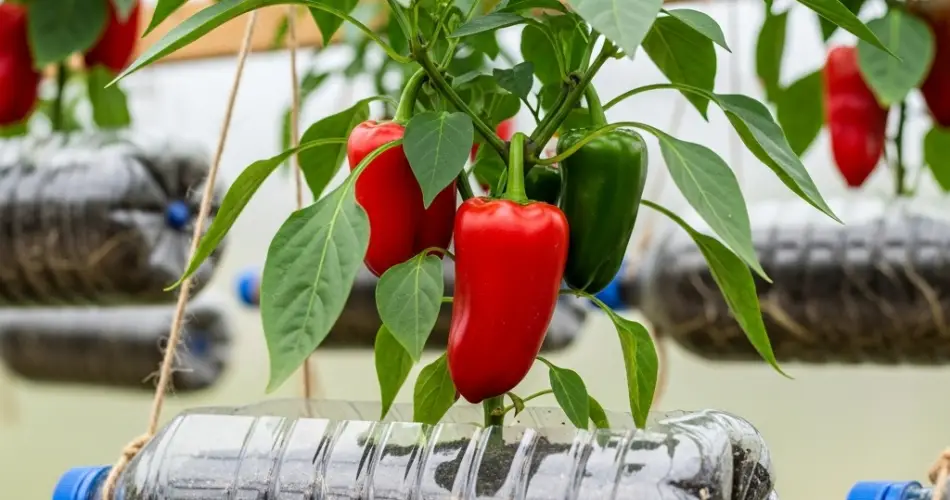Peppers are a favorite among home gardeners, offering vibrant colors, bold flavors, and a touch of spice or sweetness depending on the variety. However, these warm-season plants can be tricky to start, especially in cooler climates or during unpredictable early spring weather. One clever and sustainable solution is to use recycled plastic bottles as mini greenhouses. This simple method creates the ideal microclimate for germinating pepper seeds and nurturing strong seedlings, even in small spaces like balconies or patios.
Why Use Bottles for Pepper Starts?
Peppers need warmth and consistent moisture to sprout successfully. Using bottles as mini greenhouses provides several benefits:
-
Temperature regulation: Bottles trap heat, creating a warm, stable environment for germination.
-
Moisture control: Enclosed spaces reduce evaporation, keeping the soil evenly moist without frequent watering.
-
Recycling advantage: Empty plastic bottles get repurposed instead of discarded.
-
Compact setup: Perfect for those without access to large greenhouses or garden plots.
-
Protection: Seedlings are shielded from drafts, pests, and sudden weather changes.
This method combines eco-friendliness with practicality, giving you a head start on the pepper season.
Choosing the Right Bottles
Medium to large plastic bottles, such as 1.5–2 liter soda bottles, work best. Clear bottles are ideal because they allow sunlight to penetrate, while also creating a humid, greenhouse-like environment. Smaller bottles can work too, but larger ones give seedlings more vertical room as they grow.
Before use, wash bottles thoroughly and remove labels to maximize light exposure.
Preparing the Bottles
To make your mini greenhouses:
-
Cut the bottle – Slice it horizontally about two-thirds of the way up. The bottom section will hold soil, and the top half will act as the lid.
-
Add drainage holes – Use a heated nail or sharp tool to make small holes in the bottom to prevent waterlogging.
-
Fill with soil – Use a light, well-draining seed-starting mix enriched with a little compost. Avoid heavy garden soil, which may compact and slow growth.
Once prepared, you’ll have a simple yet effective propagation container.
Starting Pepper Seeds
Pepper seeds can be sown directly into the soil-filled bottle bases. Plant them about 0.5 cm deep and lightly cover with soil. Mist the surface with water to keep it moist. Place 2–3 seeds in each bottle cell, as not all may germinate. Once seedlings emerge, thin them out to leave the strongest plant.
Close the bottle by sliding the top half back over the base. This creates the mini greenhouse effect. If the fit is too tight, hinge it using tape on one side so it can be easily opened for watering and ventilation.
Finding the Best Location
Pepper seeds germinate best in warmth. Place your bottle greenhouses in a bright indoor spot, such as a sunny windowsill, or on a sheltered balcony where they receive indirect sunlight. Avoid direct midday sun, which may overheat the enclosed bottles.
If the environment is cool, consider placing the bottles near a heat source or using a heating mat to maintain soil temperatures around 24–28°C (75–82°F), the ideal range for pepper germination.
Watering and Ventilation
Because bottles trap moisture, watering needs are minimal. Check the soil daily and mist lightly if it appears dry. To prevent mold or fungal issues, occasionally open the bottle tops for ventilation, especially once seedlings emerge. This helps them adapt to the outside environment gradually.
As plants grow, you can leave the caps off the bottles or open the tops during the day, closing them again at night for warmth.
Transplanting Pepper Seedlings
After 4–6 weeks, when seedlings develop several true leaves and are about 10–15 cm tall, they’re ready to be transplanted. Gently remove the seedling along with its root ball from the bottle. Transplant into larger pots, raised beds, or garden soil once temperatures outdoors remain consistently warm.
Before transplanting outdoors, harden off the seedlings by gradually exposing them to outdoor conditions for a week. Start with a couple of hours in light shade, then slowly increase sun exposure and duration.
Benefits Beyond Peppers
While this method works beautifully for peppers, the same bottle greenhouse technique can be used for other warmth-loving crops such as tomatoes, eggplants, and cucumbers. It’s a versatile, sustainable approach to seed starting that fits well with small-space or urban gardening.
Final Thoughts
Growing peppers from seed doesn’t require expensive equipment or a large greenhouse. With a few recycled plastic bottles, you can create an effective and eco-friendly seed-starting system right at home. The bottle greenhouse method provides warmth, moisture, and protection—everything pepper seeds need to thrive.
By the time the weather is ready for outdoor planting, you’ll have strong, healthy seedlings prepared to take off in the garden. This simple practice not only supports sustainable living by reusing materials but also makes it possible for anyone, anywhere, to enjoy the satisfaction of growing their own peppers.



